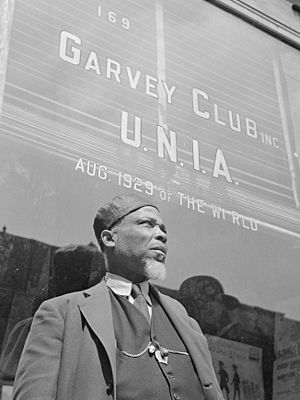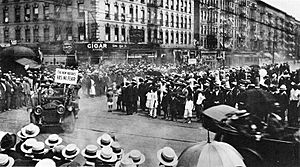Universal Negro Improvement Association and African Communities League facts for kids

Garvey Club Inc. U. N. I. A. New York City office in April 1943 and a member
|
|
| Abbreviation | UNIA |
|---|---|
| Motto | One God! One Aim! One Destiny! |
| Formation | July 15, 1914 |
| Founder | Marcus Garvey, Amy Ashwood Garvey |
| Founded at | Jamaica |
|
President
|
Cleo Miller, Jr. |
The Universal Negro Improvement Association and African Communities League (UNIA-ACL) was a special group started by Marcus Garvey and Amy Ashwood Garvey. Marcus Garvey was an immigrant from Jamaica who moved to the United States. This group aimed to unite people of African descent around the world.
The UNIA-ACL was very strong in the 1920s. It had a big impact on African Americans and their history. Even after Garvey left the U.S. in 1927, the organization continued to be important. It was seen as a leading group in Jamaica before 1938.
The main goal of the UNIA was to help people of African heritage everywhere. Their motto was "One God! One Aim! One Destiny!" Their slogan was "Africa for the Africans, at home and abroad!" To achieve its goals, the UNIA created many smaller groups. These included the African Legion (a group like a military force) and the African Black Cross Nurses. They also started businesses like the Black Star Steamship Line and the Negro Factories Corporation.
Contents
What Does UNIA-ACL Mean?
Marcus Garvey explained how the organization got its name. In 1923, he wrote about a conversation he had on a ship. He met a man from the West Indies who had been in Africa. The man told him sad stories about life for native people in Africa.
Garvey thought deeply about these stories. He realized he wanted to create an organization that would help all Black people. He decided to call it the Universal Negro Improvement Association and African Communities (Imperial) League. He believed this name would show its purpose to help all Black humanity.
How the UNIA Began
Marcus Garvey was born in Saint Ann's Bay, Jamaica. When he was 23, he traveled through Central America and lived in England for a while. During his travels, he became sure that Black people needed to unite to improve their lives.
He returned to Jamaica in July 1914 and started the UNIA in Kingston. His goal was to bring together all people of African descent. After visiting the United States in 1916, Garvey opened the New York branch of the UNIA in 1918. It started with just 13 members.
Spreading the Word: The Negro World Newspaper
The UNIA launched its own newspaper, The Negro World, on August 17, 1918. This weekly paper shared the organization's ideas. Garvey wrote an editorial each week, explaining the UNIA's views on issues affecting people of African heritage.
The newspaper became very popular, claiming to reach 500,000 readers. It was printed in several languages and had a special page for women. The Negro World reported on events related to people of African descent worldwide. It was distributed across the African diaspora until it stopped publishing in 1933.
Liberty Halls and Businesses
In 1919, the UNIA bought its first Liberty Hall in Harlem, New York City. This large building could hold 6,000 people. It was used for weekly UNIA meetings and also had a restaurant. The UNIA later bought more Liberty Halls in other countries.
The Association also started businesses to help its members.
- The Black Star Line, Inc. (BSL) was a shipping company started in 1919. It raised money by selling shares for five dollars each. The BSL bought ships like the SS Yarmouth and the SS Shady Side. The Shady Side was used for fun trips and rented out. They later bought a third ship, the Kanawha, for travel between islands in the West Indies.
- The Negro Factories Corporation was also started in 1919. It aimed to create jobs and income. It ran several businesses, including grocery stores, restaurants, a laundry, and a printing company. These businesses created about 700 jobs.
The UNIA grew a lot from 1918 to 1924. They bought more Liberty Halls in the US, Canada, and other countries. They also bought farms in places like Ohio. They even bought land in Claremont, Virginia, hoping to build a university called Liberty University.
First Big Meeting: The International Convention
By 1920, the UNIA had over 1,900 local groups in more than 40 countries. Most of these groups were in the United States, which became the UNIA's main base. There were also offices in the Caribbean, Central and South America, Africa, India, and Australia.
In August 1920, the UNIA-ACL held its first international convention. It took place at Madison Square Garden in New York City. About 20,000 members attended. On August 13, 1920, they created "The Declaration of Rights of the Negro Peoples of the World". They also elected the UNIA leaders as "leaders for the Negro people of the world."
This convention helped the movement grow as a force for Black nationalism. It focused on uplifting the Black race and encouraged self-reliance. One important declaration was making the red, black, and green flag the official flag of the African race. This flag later became known as the Black Liberation Flag. The UNIA-ACL also chose the song "Ethiopia, Thou Land of Our Fathers" as its official anthem.
During the convention, Marcus Garvey was elected "Provisional President of Africa." This was mostly an honorary title. George Alexander McGuire, a priest, became the first chaplain-general of the UNIA. He wrote important documents for the organization, drawing on his knowledge of religion and history.
A highlight of the 1920 convention was the opening parade. It started outside the UNIA headquarters in Harlem and marched through the streets. The parade included mounted police, UNIA officials, the Black Star Line Choir, and groups from many countries. There were 12 bands and about 500 cars. Similar impressive parades were held in 1922 and 1924. Many photos of the 1924 parade were taken by the famous photographer James Van Der Zee.
Even after Garvey left Harlem, the UNIA continued to hold parades each August. These parades featured uniformed UNIA members, especially the African Legion and Black Cross Nurses. Crowds were amazed by the spectacle.
The UNIA's constitution describes it as a social, friendly, and educational group. Its members promised to work for the uplift of people of African ancestry worldwide. They also pledged to respect the rights of all people, believing in "the Brotherhood of Man and the Fatherhood of God."
The Liberian Program
The UNIA also worked to help African Americans who wanted to move to Africa. In late 1923, a UNIA group visited Liberia to look for land to buy. They also checked the conditions in the country for UNIA members who might want to live there.
In 1924, the Chief Justice of Liberia, J. J. Dossen, wrote to the UNIA. He said that the Liberian government supported the UNIA's goals. He promised they would help the Association with its business and farming plans in Liberia.
However, about two months later, the Liberian President suddenly stopped all members of the "Garvey Movement" from entering Liberian ports. This happened shortly after the Firestone Rubber Company made a deal with Liberia. Firestone leased one million acres of land for 99 years to grow rubber. This deal was supported by American and European governments. The UNIA had originally planned to lease land from Liberia for a very low price. The Firestone deal greatly hurt the UNIA's plan to help people move to Africa.

After Marcus Garvey
After Marcus Garvey left the U.S. in 1927, the UNIA changed. Many of his supporters were upset and formed other groups. However, the UNIA continued to operate.
Garvey appointed Maymie de Mena as his official representative in America. She was a powerful speaker who spoke both Spanish and English. She helped the organization grow in Latin America and the Caribbean.
The UNIA Inc.
The UNIA, Inc. continued to work from New York until 1941. Over the years, different leaders took charge. In 1941, the main office moved to Belize. Later, it moved back to New York.
The UNIA-ACL 1929 of the World
Another branch, the UNIA-ACL 1929, was led by Marcus Garvey himself in Jamaica. He later moved to England in 1935 and continued to lead from there. Conventions for this branch were held in Canada in the late 1930s. Garvey even taught the first course on African philosophy during these meetings.
Marcus Garvey passed away in 1940. Members worldwide held services to honor him. James R. Stewart became the next leader. He moved the main office to Cleveland, Ohio.
Parent Body in Monrovia
In 1949, James R. Stewart moved to Monrovia, Liberia. He became a Liberian citizen and moved the UNIA's main office there. He led the Association until he passed away in 1964. Stewart and his family even started a hospital, school, and farm in Liberia.
After Stewart's death, the main office moved back to the United States. Cleo Miller, Jr. has held the title of President General since 1988.
Important People in the UNIA
- Dusé Mohamed Ali
- Amy Ashwood Garvey
- John Edward Bruce
- Eliezer Cadet
- Henrietta Vinton Davis
- William H. Ferris
- Arnold Josiah Ford
- Timothy Thomas Fortune
- Amy Jacques Garvey
- Marcus Garvey
- St. William Grant
- Hubert Henry Harrison
- Thomas Watson Harvey
- Samuel Alfred Haynes
- Hubert Julian
- Louise Little
- Maymie de Mena
- George Alexander McGuire
- Isaiah Emmanuel Morter
- Solomon Plaatje
- Robert Lincoln Poston
- Thomas Vincent Ramos
- James Robert Stewart
- Eric D. Walrond
See also
 In Spanish: Asociación Universal de Desarrollo Negro y la Liga de Comunidades Africanas para niños
In Spanish: Asociación Universal de Desarrollo Negro y la Liga de Comunidades Africanas para niños



